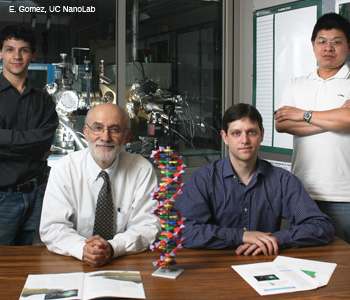Feature
DNA as an Optical Material
DNA, the beautifully symmetrical “molecule of life,” carries the core genetic blueprint for every living organism. Now, through the emerging field of DNA photonics, it also has the potential to serve as an inexpensive, renewable resource in the development of optical waveguides, organic LEDs and laser structures.
 DNA photonics team at the University of Cincinnati. (Left to right) Eliot Gomez, Andrew Steckl, Hans Spaeth and Han You.
DNA photonics team at the University of Cincinnati. (Left to right) Eliot Gomez, Andrew Steckl, Hans Spaeth and Han You.
Most of us have at least a superficial knowledge of what deoxyribonucleic acid (DNA) is and how it determines our genetic makeup through its sequence of base pairs. However, many do not realize just how much DNA organisms have: In humans, for example, the total length of the DNA in the chromosomes of a cell is of the same order as the length of a human being (about 1.5 to 2 m). This very long and very “skinny” molecule (roughly 2 nm in diameter) is compressed into a tight ball within the nucleus of each cell (around 1 µm in diameter). Compacted DNA, along with some protein, floats in a watery solution.
…Log in or become a member to view the full text of this article.
This article may be available for purchase via the search at Optica Publishing Group.
Optica Members get the full text of Optics & Photonics News, plus a variety of other member benefits.
